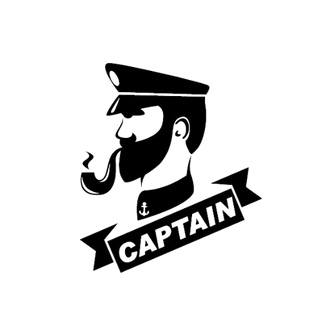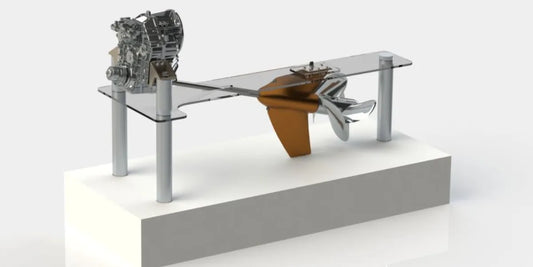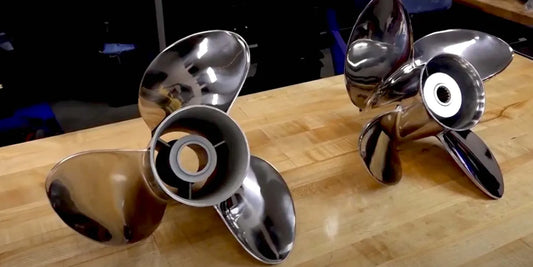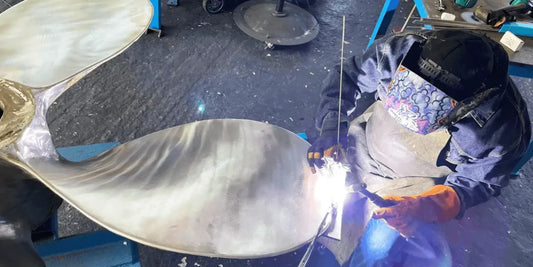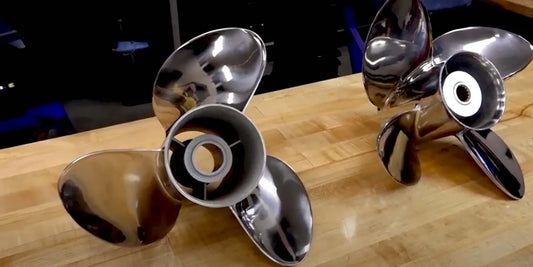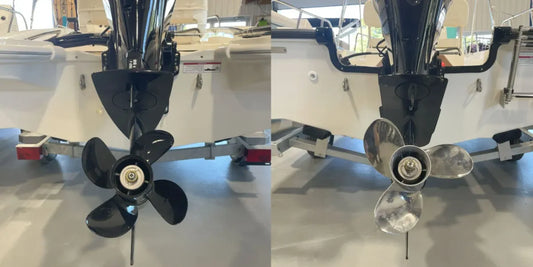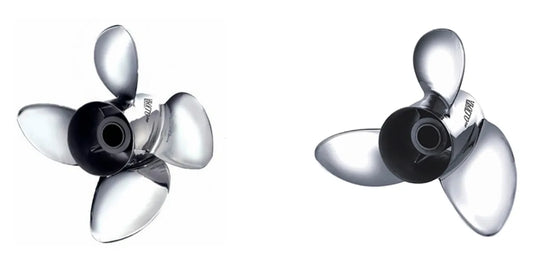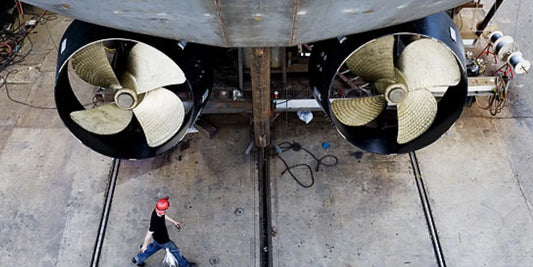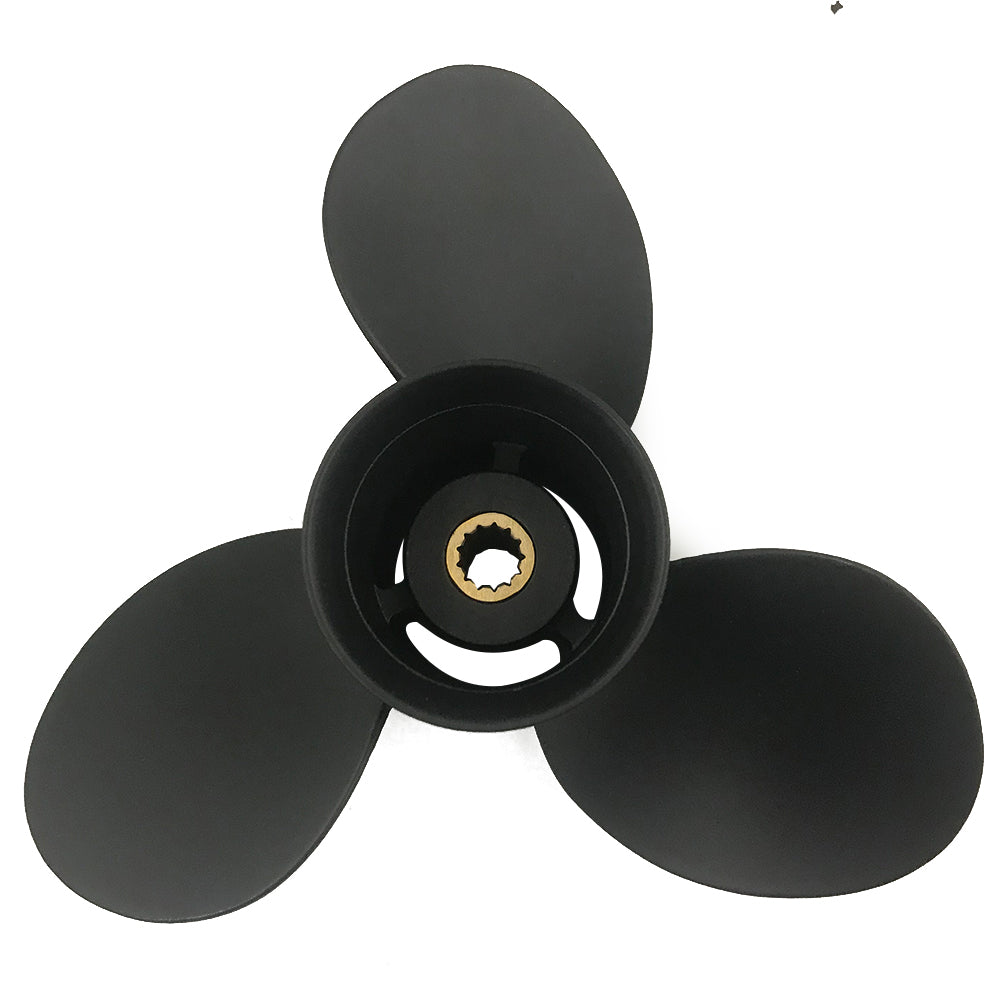A boat propeller rendering service is ultimately what sellers will rely on to align boat performance characteristics with boat marketing. An experienced boater will fine-tune the settings, while a novice wants to know the basics. In other words, there is much to select from in a propeller for an outboard or inboard engine. The choice of the propeller is one of the most significant determinants of speed, fuel economy, maneuverability, and overall boating experience. This guide will help paint the bigger picture by highlighting factors to consider, types of propellers, and how to match a propeller with an engine and its usage for a successful outcome. After this article, a reader will practically know how to make a propeller choice for the performance and life of their boat.
Understanding Boat Props and Their Importance

What is a Boat Propeller?
A boat has one essential component in the propulsion system: the propeller, whereby the rotating energy from the engine is converted to thrust, pushing the boat forward or backward through the water. Usually, aluminum or stainless steel is used to fabricate boat propellers; they consist of many blades radiating from a central hub. The blade shape, size, and pitch directly affect the speed of the boat, as well as its fuel efficiency and overall performance. Therefore, the choice of propeller is integral to achieving optimum engine output in any water conditions, whether it be for the leisurely cruise, towing, or high-speed action. When appropriately matched, the propeller significantly contributes to the efficiency, safety, and versatility of your boating experience.
How Propellers Affect Boat Performance
A propeller's material significantly affects its complexity, durability, performance, or suitability for specific boating activities. Aluminum, corrosion-resistant stainless steel, or a mixture of composites is usually chosen. Aluminum propellers, for one, are comparatively light, cheap, and suited for the bulk of casual boating or moderate-performance requirements. Stainless steel propellers offer the strength and corrosion resistance needed for challenging marine environments or high-performance uses. Composite materials, however, owing to their lightness and low maintenance, may be preferred, although they present an uncorroborated robustness that a metal could not.
Each material affects the degree to which energy is transferred from the engine to the blades and into the water: acceleration, top speed, and fuel consumption. Choosing the right material is basically balancing the cost against the specific needs of your vessel and its usage scenarios. If performance matters, stainless steel is probably the choice, while recreational users would do well to find aluminum or a composite counterpart at a reasonable price. The propeller of choice, by material, should be in sync with the expected water conditions to ensure long-term efficiency and reliability.
Boat Propeller Types: Outboard vs. Inboard
Boat propellers are distinguished mainly as either outboard or inboard, with a set of individual characteristics to meet various boating requirements. Outboard propellers are mounted outside on the engine casing at the aft of the boat. These types of props are most favored for small and medium craft, primarily because of the flexibility that comes with servicing and better maneuverability. When fishing, participating in water sports, or simply winding down, the most important thing is having some level of flexibility in accessibility.
Inboard propellers, contrarily, lie under the hull and are connected through a drive shaft to an inboard engine. Inboards are renowned for their reliability and silken running, being aimed at bigger boats or those with higher power requirements such as towing or commercial transport. They may offer better fuel economy for large equipment and perform well in rough waters; however, they may be more maintenance-prone compared to outboards. Usually, the deciding factors in choosing between the two become boat size, usage, and preferred handling characteristics. Both types can be further refined with the appropriate materials and blade design to obtain peak performance in different aquatic environments.
Materials Used in Boat Propellers

Aluminum or Stainless Steel Props?
When choosing between aluminum and stainless steel propellers, it is necessary to consider the characteristics, performance, and intended use of both materials. An aluminum propeller is a cheap and lightweight option, preferred for small to mid-sized boats and various recreational boating activities. They work well under normal operational conditions and accept easier repair than their stainless steel counterparts. But they are less intense and do get bent or warped when subjected to significant stress or impact.
Conversely, stainless steel propeller types are known for their exceptional strength and durability. It can do heavy-duty operations at incredibly high speeds. The other kinds of props ensure the acceleration reaches its peak in situations with depredations or rough waters. Stainless steel propellers have a generally higher price tag, but for major boating enthusiasts and experts who require rock-solid reliability for performance every time, it is a worthy investment.
So, it really depends on the captain's priorities: cost and ease of maintenance, or long-term durability and better performance.
Advantages of Special Materials
Specialty materials, e.g., composite blends or advanced alloys, have piqued the interest of several industries in the recent years because of their unique performance characteristics and flexibility. These materials are mostly lightweight with an excellent strength-to-weight ratio, which is known as more efficient and durable for the task at hand. They counteract corrosion, impact, and wear, thus lengthening the life span of a product in a very tough environment. Industries can also develop specialty materials for specific needs, such as reducing fuel consumption in transport or enhancing aerodynamics in the marine environment. Villa Design provides a significant headline to this product research with state-of-the-art innovative solutions that balance practicality with technology.
Choosing the Right Material for Your Needs
Selecting the most suitable material for your application involves considering some key factors. Start by examining performance requirements like strength, durability, thermal resistance, or flexibility, as these factors indicate how well the material can withstand operational conditions. Another environmental consideration is how the material interacts with factors such as extreme temperatures, chemicals, or UV radiation, as these will affect material compatibility and longevity.
Another feature to keep an eye on is cost. Some exotic materials might technically perform better, but balancing the initial cost with the long-term cost is a wise investment decision. The other point of consideration nowadays is sustainability in materials, so that manufacturers can choose the environmentally friendly path to lessen environmental impact and meet regulatory standards that are forthcoming.
Finally, consider the manufacturability of the material. This considers how easily the material can be processed, molded, or fabricated according to specs. Getting an expert opinion or using some tools to analyze the properties of materials can also give you additional confidence that the material selection is appropriate for achieving what the project needs, the ground for innovation and an application.
Key Factors to Consider When Choosing Boat Props

Diameter and Pitch Explained
Choosing an ideal boat propeller requires intimate knowledge of how diameter and pitch interplay for performance optimization. The term diameter refers to the full measurement of the circle that the horizontal blades of the propeller make while spinning. Bigger diameters are typically used for slower boats that require more power to move heavy loads. Pitch is the distance the propeller would have moved if it had no slippage during one complete revolution. A higher pitch propeller means greater speeds and a lot of horsepower, while a lower pitch propeller will give you faster acceleration, more torque for towing, or quicker starts.
Selecting the correct diameter and pitch combination for your boat's engine power and application optimizes fuel consumption, ensures smooth operation, and allows it to cruise at its ideal speed. Lower pitch propellers may be desirable for water sports boats since they provide quicker acceleration, while cruisers would prefer higher pitch for greater top speed. In any case, balancing these factors with your requirements and consulting the manufacturer's specifications or guidelines should form the basis of making an informed decision.
Knowing Engine Specifications and Compatibility
When selecting an engine, one needs to consider such factors as horsepower, torque, and compatibility with the vessel. Horsepower will push the engine through various load capacities to ensure the boat reaches the intended speed for its intended purpose. Torque, however, would be essential if more pulling power were required, such as for water skiing or towing. The compatibility of the engine with the hull type and weight of the boat is, therefore, equally important so as not to compromise performance and stability.
In contemporary engines, features like EFI systems exist to provide excellent fuel efficiency and reliability. Digital integrated controls are also there for exact operation. All these innovations ease the maintenance load and enhance the boating experience. When checking for compatibility, always see that the engine suits the transom dimensions, mounting configuration, and electrical system requirements of your boat. Considering these specifications shall ensure that your engine is ideally suited to your vessel's needs, prepared to give maximum output and longevity.
Weight and Power: Their Effects on Prop Selection
In the selection of the propeller, weight and power of the vessel are the primary factors that influence performance, fuel efficiency, and handling. The heavier the vessel, the more thrust is needed to accelerate properly and maintain speed. Hence, the propellers must be chosen with a lower pitch that provides maximum power at lower RPMs. In contrast, light boats experience greater efficiency once they use a high-pitch prop to hit faster speeds.
Engine power demands careful consideration when choosing a propeller. Mighty engines take on high-pitch props, designed to deliver maximum speed. Low horsepower just cannot take the abuse of a high-pitch prop, which would be the perfect operating condition for it if it could. Propellers must be suited to the weight of both your boat and the power of the engine, ensuring that they deliver the proper thrust, speed, and lasting ability. If one were aware of these dynamics, then smooth running would be guaranteed, whether cruising, towing, or hitting crazy speeds. Manufacturer recommendations should always be observed and followed. If all means are too complicated, try out the propeller to verify whether its finish also contributes to better performance.
Popular Brands and Models of Boat Props

Mercury Propellers: Features and Benefits
Mercury propellers have a good reputation in the boating industry for their durability, precision engineering, and innovative designs that fit diverse boating applications. The main feature is their advanced blade geometry. This helps increase acceleration and the top speed of a vessel while decreasing fuel consumption. They also use only the best materials in crafting their propellers, which are made either from stainless steel or aluminum, ensuring they will last and perform well despite harsh marine conditions.
Further, Mercury offers several models geared toward special applications: Enertia series for high-powered boats or Spitfire series for faster hole shots and midrange power. Adding to that versatility is their patented Flo-Torq hub system, which allows a quick-fit, plug-and-play application to different engine shafts. Mercury propellers, therefore, stand for consistency in performance and fuel efficiency; that is why a boater looking to upgrade his or her on-water experience will put their faith in the brand.
Acme Props: Perspectives on Performance
For years, Acme Props has been known for precision engineering and reliability across the entire gamut of boating applications. Created with the ultimate CNC machining technology, the propellers offer supreme accuracy in blade geometry, enhancing speed and fuel efficiency. Acme offers a wide range to appeal to everyone, from watersports enthusiasts who require maximum torque and acceleration to those who just want a smooth, easy ride. There is also innovation on the materials front as high-strength alloys are used to provide durability and long performance. It is a favorite of boaters everywhere who appreciate the platform for its refined handling, reduced vibrations, and thrust efficiency.
Volvo Penta and Other Important Brands
Volvo Penta is one of the most trusted names in marine propulsion systems, known for innovations and aiding reliability. The company's propulsion systems transform the yards with precision maneuvering, reduced fuel consumption, and lesser noise. An exception is the renowned IPS, which combines the forward-facing dual propellers with joystick steering that lets a technician dock a boat with surgical precision in tricky conditions.
Other worthy brands continue to push the industry towards better engineering and design. Yamaha Marine, for instance, produces outboard motors that combine horsepower with efficiency, whereas Mercury Marine specializes in propellers best suited for either fast cruising or leisure cruising. Together, these brands address the varied needs of end-users, ensuring boaters are pushed to cutting-edge technology that enhances their water-bound experiences.
Maintenance Tips for Boat Propellers

Regular Maintenance Is a Must
Proper propulsion requires thorough inspection and cleaning of the propellers. I make it a point to inspect my propellers before the start, visually, and once the trip is over. This way, I can check for any kind of damage, such as dents, cracks, or bent blades, that can hamper performance or fuel efficiency. If left unattended, it could lead to further damage to the motor or associated parts. I also make an effort to remove any fishing lines or rubbish that are often tangled around the propeller, so as not to put undue strain on the engine.
Cleaning holds equal importance, especially after a run through salt water or over heavy vegetation. I wash off grime, salt deposits, and algae with mild soap and water. Scrubbing with a soft brush is the way to go, as it does not scratch. For persistent spots, non-abrasive marine cleaners help restore the surface of the propeller. Clean propellers ensure smooth operation, from preventing corrosion to doubling the lifespan of the equipment.
Lastly, the propeller hub and shaft require attention by applying a coat of marine grease to prevent rust and facilitate easy assembly and disassembly. Such upkeep has tremendously enhanced the boat's performance and reliability in my experience. Just a bit of care for this special component will secure a pleasant and glitch-free escapade on the waters.
Recognizing and Treating Propeller Damage
The first step in determining whether my boat's propeller has damage is the visual inspection as a form of routine maintenance. I inspect the blades for any irregularities such as bends, cracks, or chips because anything that offsets the propeller's ability to generate thrust will result in poor performance or reduced fuel economy. Even the slightest chip in a blade will cause the propeller to be out of balance and generate that vibration, which, with time, will destroy the engine or thrust shaft. For minor dents and deformations, I usually consider a quick fix with a prop repair kit, but bigger issues demand the skills of a repairman to restore the prop to good working condition.
Another significant aspect to consider is corrosion, especially in saltwater environments. Corrosion may degrade the structure of the propeller, resulting in reduced effectiveness. Ensuring that the propeller is coated correctly and checking it for signs of pitting or discoloration helps to prevent this. Also, I inspect the propeller hub and shaft for wear, as such damage can occur over time or due to impacts with submerged objects. Should I encounter a damaged hub or excessive shaft play, I know that a replacement of the hub insert is due, or it's time to call in a professional.
Also, I learned to listen for unusual sounds or vibrations while the boat is in motion, as they may indicate invisible damage. If the prop appears intact from a visual standpoint but still exhibits performance issues, I would consider balancing it or having an expert inspect it for hidden cracks or internal defects. Quickly correcting such matters prevents further damage and guarantees reliable and efficient service from the boat, allowing all my attention to focus on enjoying myself on the water.
Boat Propeller Replacement Time
Hence, it is essential to replace the boat propeller if performance is suffering due to signs of wear and damage. One of the clearest indicators for me is physical damage, such as bent or chipped blades, caused by hits against underwater objects. Even a small dent can cause an imbalance that disturbs fuel efficiency and produces vibrations during operation. Whenever such symptoms surface, I defer to a close inspection of the propeller and recommend replacement if it cannot be repaired to a functional state.
Another critical factor is the strain or underperformance of the engine. For example, if my boat has trouble reaching its normal speed or the engine is going over-revs, it often indicates that the propeller can no longer deliver adequate thrust. Due to excess wear or incorrect sizing, this situation might arise. I also keep a close watch over my boating habits and schedule since one who uses the boat frequently in areas considered tough, such as rocky or shallow waters, will have an increasing possibility of sustaining prop damage along the way. Being proactive is the best way to ensure a smooth-running engine; hence, replacing a worn-down prop early saves the engine from prolonged stress.
This is where technology comes into play as a motive for change: upgrading to a newer and more efficient propeller will guarantee better handling, fuel economy, and even top speed for the boat. Newer materials and design options, such as stainless steel props or four-blade configurations, may fit better with how I actually use my boat compared to the old propeller. The change of propeller is definitely worth considering for safety and enjoyment on the water, whether the demand is for enhanced performance in general or something more suitable for my specific boating needs.
Reference Sources
-
How to Choose the Right Prop for Your Boat
This guide explains how to determine the proper propeller size based on your boat and engine's wide-open throttle (WOT) range. -
Understanding the Different Types of Boat Propellers
Offers insights into the pros and cons of stainless steel and aluminum propellers, focusing on performance and durability. -
How to Pick the Right Prop for Your Boat
This text discusses various propeller options and helps boat owners identify the best fit for their specific needs. -
Choosing the Correct Boat Propeller
A comprehensive guide on how different propeller designs impact efficiency, power, and speed, with tips for selecting the right one. -
Reddit Discussion on Boat Prop Efficiency
A community discussion highlighting real-world experiences with prop slip, efficiency, and performance improvements.
Frequently Asked Questions (FAQs)
What different types of boat propellers exist under this?
A boat propeller can be steel, aluminum, or a specialty type. Stainless steel propellers are very durable and perform well, making them well-suited for engines equipped with such high horsepower as 450hp. Aluminum props tend to offer more economical pricing and are good for recreational boating. Specialty types, like those for outboard motor applications, might incorporate one or more cupped blades on individual blades to increase thrust and acceleration. Understanding different types of propellers can help you choose the right one to suit your own requirements.
How do I choose the proper diameter for my boat prop?
Diameter is important for a propeller because its propulsion and performance depend on it. A big diameter gives a lot of thrust, so the larger the propulsion, or the faster it needs to go, the thrust there will be with a larger diameter. On the other hand, if the diameter is too large for your engine's horsepower, cavitation will occur, reducing efficiency. Consider, firstly, your engine specifications. Then, also consider the type of experience you plan to have: Will it be towing? Skiing? Just cruising? Consider consulting a marine specialist to ensure you choose the best diameter for your boat prop.
What is the difference between 3-blade and 4-blade propellers?
They are the sizes of three-blade and four-blade propellers. In general, a 3-blade propeller produces less drag, resulting in better top speed and mileage compared to a 4-blade, which offers better acceleration and handling. This makes it a preferred choice for outboards used in towing or water sports. The choice really depends on your need for speed or torque for skiing, for instance.
What can I do to increase my fuel efficiency with my boat prop?
Making the right propeller choice is directly related to improving fuel efficiency. A stainless steel prop, for example, performs better and, hence, will end up saving some fuel compared to aluminum ones. In addition, having a correct size and pitch in your propeller will use the RPMs of your engine correctly instead of overworking it. Proper maintenance of your propeller, including checking for damage or wear, will also aid in fuel efficiency. Understanding your boat's performance parameters and adjusting the prop to match them will greatly increase your enjoyment time on the water.
What maintenance should my prop have?
Your propeller could use regular upkeep to give it the best finish. You'll need to inspect for any nicks, dents, or corrosion, even small ones, because maybe they will impact propulsion or performance. Check the shaft and bearing for proper alignment and lubrication. If you have a stainless steel propeller, watch for any wear that could cause cavitation. Regular professional inspections are worth considering, especially if you frequently operate the boat and want to keep the propeller in excellent condition.
What about propellers for high performance? When do I need to use one?
High-performance propellers maximize the thrust, acceleration, and overall efficiency for fast boats and racing. These propellers tend to have advanced designs, such as CNC-machined blades with a cupped edge for better water flow and reduced drag. For greater synchronization in speed and lifting power in any higher-horsepower engine, the Mercury or Yamaha V6 configuration, a high-performance prop would be well-suited. One might not need a high-performance prop for casual cruising, though, and one must always check the suitability for their specific needs.
